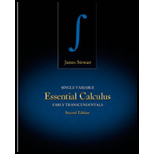
Single Variable Essential Calculus: Early Transcendentals
2nd Edition
ISBN: 9781133112785
Author: James Stewart
Publisher: Cengage Learning
expand_more
expand_more
format_list_bulleted
Concept explainers
Textbook Question
Chapter 2.2, Problem 4E
Trace or copy the graph of the given function .f. (Assume that the axes have equal scales.) Then use the method of Example 1 to sketch the graph of f' below it.
Example 1
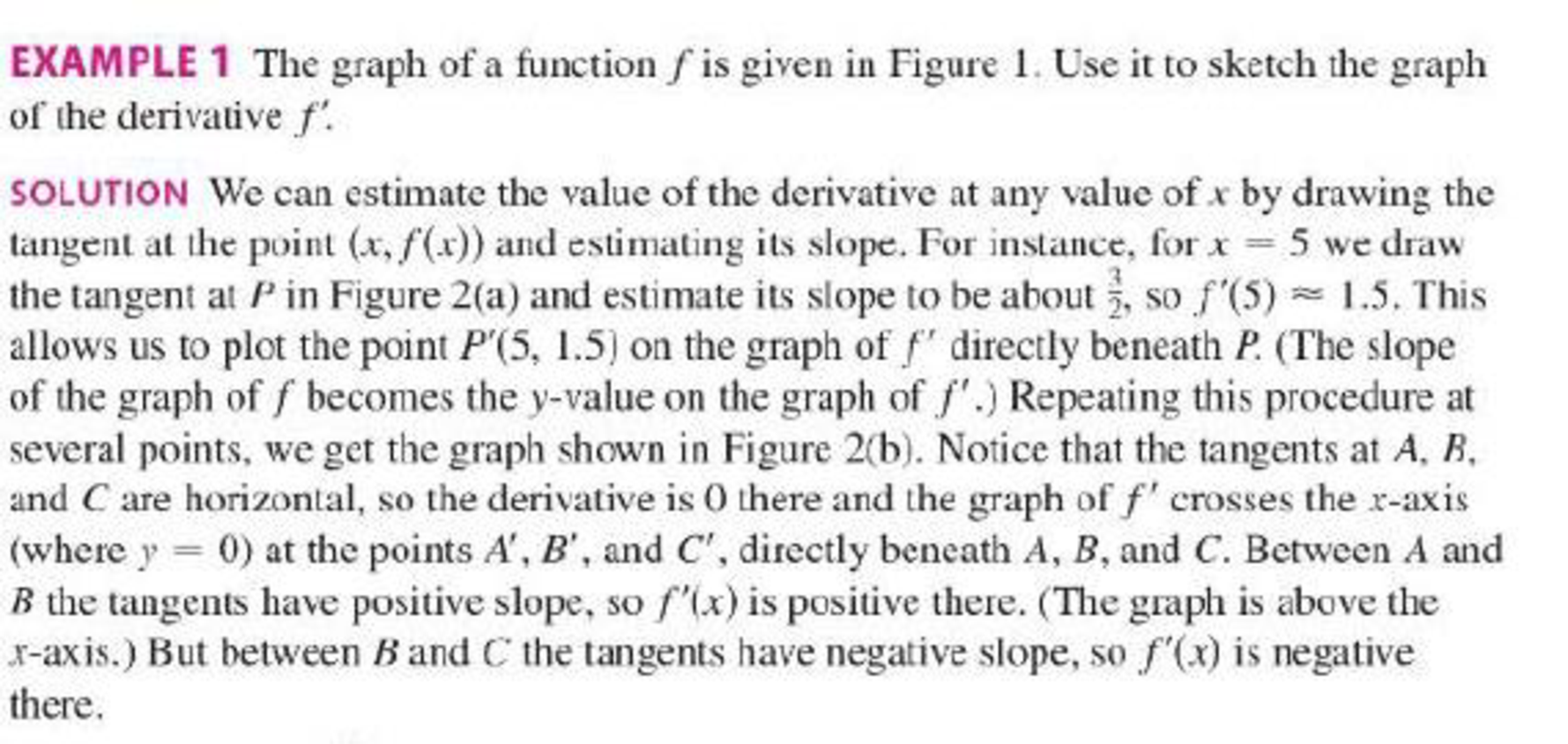
FIGURE 1
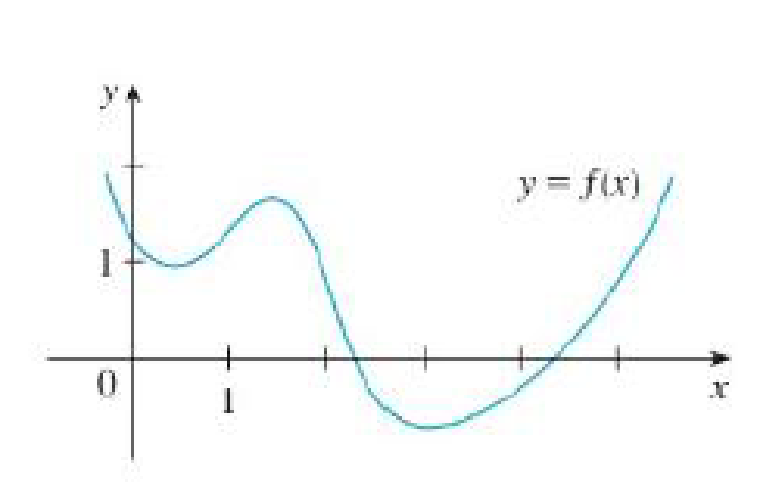
FIGURE 2
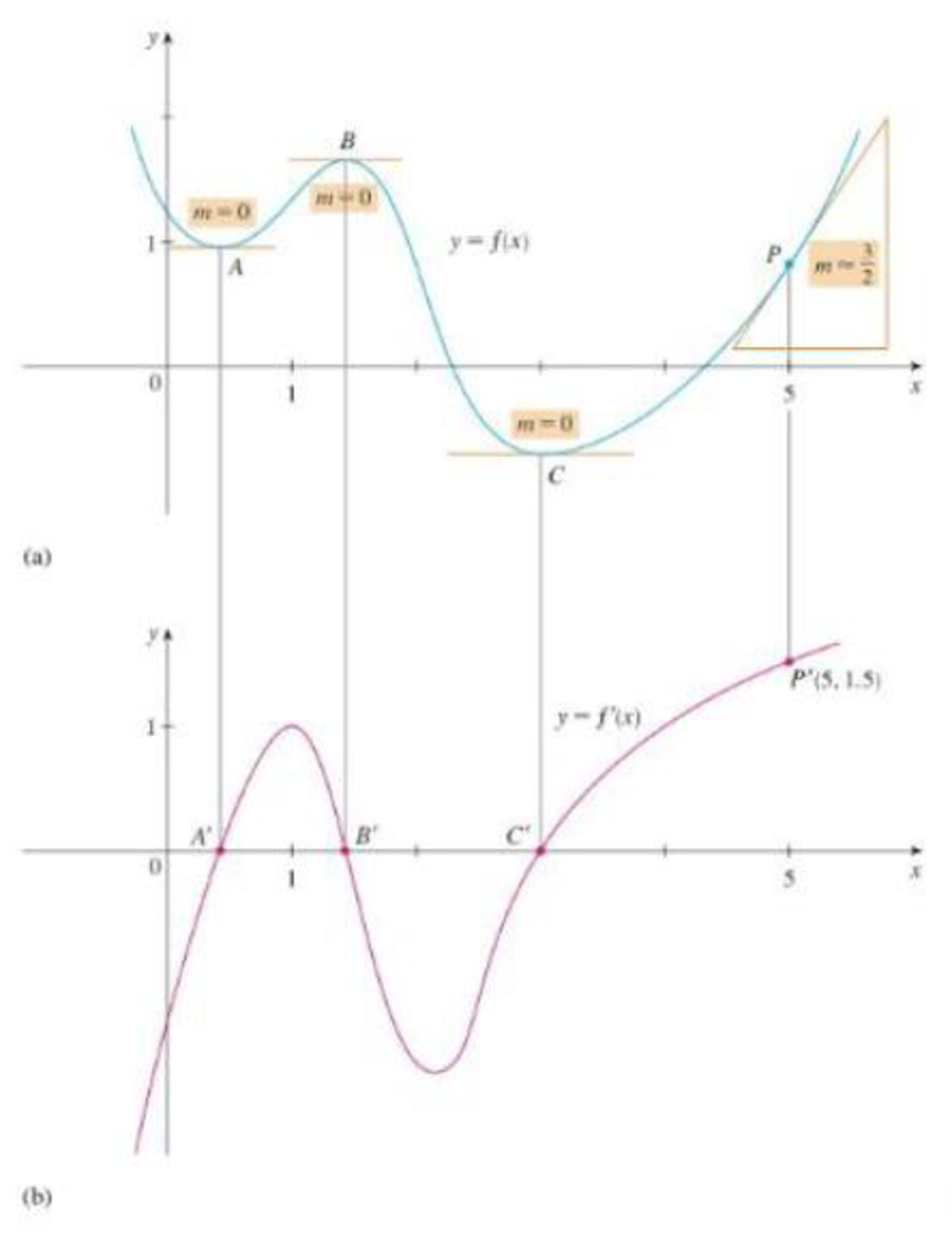
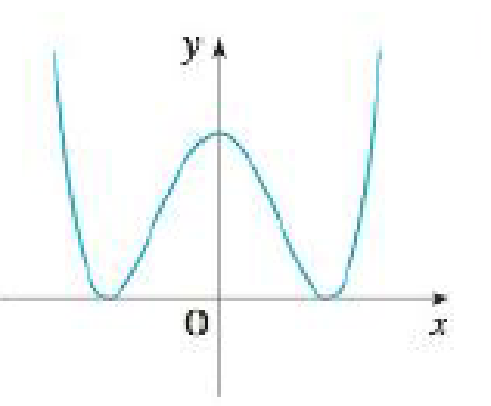
Expert Solution & Answer
Want to see the full answer?
Check out a sample textbook solution
Students have asked these similar questions
An airplane flies due west at an airspeed of 428 mph. The wind blows in the direction of 41° south of west
at 50 mph. What is the ground speed of the airplane? What is the bearing of the airplane?
428 mph
41°
50 mph
a. The ground speed of the airplane is
b. The bearing of the airplane is
mph.
south of west.
Rylee's car is stuck in the mud. Roman and Shanice come along in a truck to help pull her out. They attach
one end of a tow strap to the front of the car and the other end to the truck's trailer hitch, and the truck
starts to pull. Meanwhile, Roman and Shanice get behind the car and push. The truck generates a
horizontal force of 377 lb on the car. Roman and Shanice are pushing at a slight upward angle and generate
a force of 119 lb on the car. These forces can be represented by vectors, as shown in the figure below. The
angle between these vectors is 20.2°. Find the resultant force (the vector sum), then give its magnitude
and its direction angle from the positive x-axis.
119 lb
20.2°
377 lb
a. The resultant force is
(Tip: omit degree notations from your answers; e.g. enter cos(45) instead of cos(45°))
b. It's magnitude is
lb.
c. It's angle from the positive x-axis is
Find a plane containing the point (3, -3, 1) and the line of intersection of the planes 2x + 3y - 3z = 14
and -3x - y + z = −21.
The equation of the plane is:
Chapter 2 Solutions
Single Variable Essential Calculus: Early Transcendentals
Ch. 2.1 - (a) Find the slope of the tangent line to the...Ch. 2.1 - (a) Find the slope of the tangent line to the...Ch. 2.1 - Find an equation of the tangent line to the curve...Ch. 2.1 - Find an equation of the tangent line to the curve...Ch. 2.1 - Find an equation of the tangent line to the curve...Ch. 2.1 - Find an equation of the tangent line to the curve...Ch. 2.1 - (a) Find the slope of the tangent to the curve y =...Ch. 2.1 - (a) Find the slope of the tangent to the curve...Ch. 2.1 - The graph shows the position function of a car....Ch. 2.1 - Shown are graphs of the position functions of two...
Ch. 2.1 - If a ball is thrown into the air with a velocity...Ch. 2.1 - If an arrow is shot upward on the moon with a...Ch. 2.1 - The displacement (in meters) of a particle moving...Ch. 2.1 - The displacement (in meters) of a particle moving...Ch. 2.1 - Prob. 15ECh. 2.1 - Find an equation of the tangent line to the graph...Ch. 2.1 - If an equation of the tangent tine to the curve y...Ch. 2.1 - If the tangent line to y= f(x) at (4, 3) passes...Ch. 2.1 - Sketch the graph of a function f for which f(0) =...Ch. 2.1 - Sketch the graph of a function g for which g(0) =...Ch. 2.1 - If f(x) = 3x2 x3 , find f'(l) and use it to find...Ch. 2.1 - Prob. 22ECh. 2.1 - (a) If F(x) = 5x/(l + x2), find F'(2) and use it...Ch. 2.1 - Prob. 24ECh. 2.1 - Find f'(a). f(x) = 3x2 4x + 1Ch. 2.1 - Find f'(a). f(t) = 2t3 + tCh. 2.1 - Prob. 27ECh. 2.1 - Prob. 28ECh. 2.1 - Prob. 29ECh. 2.1 - Prob. 30ECh. 2.1 - Each limit represents the derivative of some...Ch. 2.1 - Each limit represents the derivative of some...Ch. 2.1 - Prob. 33ECh. 2.1 - Prob. 34ECh. 2.1 - Prob. 35ECh. 2.1 - 3136 Each limit represents the derivative of some...Ch. 2.1 - Prob. 37ECh. 2.1 - Prob. 38ECh. 2.1 - The number N of US cellular phone subscribers (in...Ch. 2.1 - The number N of locations of a popular coffeehouse...Ch. 2.1 - Prob. 41ECh. 2.1 - If a cylindrical tank holds 100,000 gallons of...Ch. 2.1 - The cost of producing x ounces of gold from a new...Ch. 2.1 - The number of bacteria after r hours in a...Ch. 2.1 - Prob. 45ECh. 2.1 - Prob. 46ECh. 2.1 - Prob. 47ECh. 2.1 - The graph shows the influence of the temperature T...Ch. 2.1 - Prob. 49ECh. 2.1 - Prob. 50ECh. 2.2 - Use the given graph to estimate the value of each...Ch. 2.2 - Use the given graph to estimate the value of each...Ch. 2.2 - Match the graph of each function in (a)(d) with...Ch. 2.2 - Trace or copy the graph of the given function .f....Ch. 2.2 - Trace or copy the graph of the given function .f....Ch. 2.2 - Prob. 6ECh. 2.2 - Prob. 7ECh. 2.2 - Prob. 8ECh. 2.2 - Prob. 9ECh. 2.2 - Trace or copy the graph of the given function .f....Ch. 2.2 - Trace or copy the graph of the given function .f....Ch. 2.2 - Shown is the graph of the population function P(t)...Ch. 2.2 - Prob. 13ECh. 2.2 - Prob. 14ECh. 2.2 - Prob. 15ECh. 2.2 - Prob. 16ECh. 2.2 - Prob. 17ECh. 2.2 - Prob. 18ECh. 2.2 - Find the derivative of the function using the...Ch. 2.2 - Find the derivative of the function using the...Ch. 2.2 - Find the derivative of the function using the...Ch. 2.2 - Find the derivative of the function using the...Ch. 2.2 - Find the derivative of the function using the...Ch. 2.2 - Find the derivative of the function using the...Ch. 2.2 - Prob. 25ECh. 2.2 - Prob. 26ECh. 2.2 - Prob. 27ECh. 2.2 - Prob. 28ECh. 2.2 - Prob. 29ECh. 2.2 - Prob. 30ECh. 2.2 - The unemployment rate U(t) varies with time. The...Ch. 2.2 - Prob. 32ECh. 2.2 - Prob. 33ECh. 2.2 - Prob. 34ECh. 2.2 - Prob. 35ECh. 2.2 - The graph of f is given. State, with reasons, the...Ch. 2.2 - Prob. 37ECh. 2.2 - Prob. 38ECh. 2.2 - Prob. 39ECh. 2.2 - Prob. 40ECh. 2.2 - Prob. 41ECh. 2.2 - Use the definition of a derivative to find f'(x)...Ch. 2.2 - Prob. 42ECh. 2.2 - If f(x) = 2x2 x3, find f'(x), f"(x), f'"(x), and...Ch. 2.2 - Prob. 45ECh. 2.2 - Prob. 46ECh. 2.2 - Prob. 47ECh. 2.2 - Where is the greatest integer function f(x) = [[ x...Ch. 2.2 - Prob. 49ECh. 2.2 - Prob. 50ECh. 2.2 - Prob. 51ECh. 2.3 - Differentiate the function. f(x) = 240Ch. 2.3 - Differentiate the function. f(x)=2Ch. 2.3 - Differentiate the function. f(t)=223tCh. 2.3 - Differentiate the function. F(x)=34x8Ch. 2.3 - Prob. 5ECh. 2.3 - Differentiate the function. f(t) = 1.4t5 2.5t2+...Ch. 2.3 - Prob. 9ECh. 2.3 - Prob. 10ECh. 2.3 - Prob. 11ECh. 2.3 - Differentiate the function. B(y) = cy6Ch. 2.3 - Differentiate the function. A(s)=12s5Ch. 2.3 - Prob. 14ECh. 2.3 - Prob. 15ECh. 2.3 - Differentiate the function. y=x(x1)Ch. 2.3 - Prob. 17ECh. 2.3 - Prob. 20ECh. 2.3 - Prob. 21ECh. 2.3 - Prob. 18ECh. 2.3 - Differentiate the function. z=Ay10+BcosyCh. 2.3 - Prob. 22ECh. 2.3 - Differentiate the function. y=x2+4x+3xCh. 2.3 - Differentiate the function. y=sin2+cCh. 2.3 - Prob. 25ECh. 2.3 - Prob. 26ECh. 2.3 - Prob. 7ECh. 2.3 - Prob. 8ECh. 2.3 - Prob. 27ECh. 2.3 - Prob. 28ECh. 2.3 - Prob. 29ECh. 2.3 - Prob. 30ECh. 2.3 - Prob. 31ECh. 2.3 - Prob. 34ECh. 2.3 - Prob. 33ECh. 2.3 - Prob. 32ECh. 2.3 - Prob. 43ECh. 2.3 - Prob. 44ECh. 2.3 - Prob. 55ECh. 2.3 - Find the points on the curve y = 2x3 + 3x2 12x +...Ch. 2.3 - Prob. 37ECh. 2.3 - Show that the curve y = 6x3 + 5x 3 has no tangent...Ch. 2.3 - Find an equation of the tangent line to the curve...Ch. 2.3 - Prob. 41ECh. 2.3 - Prob. 42ECh. 2.3 - Prob. 61ECh. 2.3 - Prob. 62ECh. 2.3 - Prob. 57ECh. 2.3 - Prob. 36ECh. 2.3 - Prob. 59ECh. 2.3 - Prob. 65ECh. 2.3 - Prob. 64ECh. 2.3 - Prob. 48ECh. 2.3 - Prob. 58ECh. 2.3 - Prob. 60ECh. 2.3 - Prob. 67ECh. 2.3 - Prob. 66ECh. 2.3 - For what values of a and b is the line 2x + y = b...Ch. 2.3 - Prob. 68ECh. 2.3 - Prob. 69ECh. 2.3 - Draw a diagram showing two perpendicular lines...Ch. 2.3 - Prob. 71ECh. 2.3 - Prob. 72ECh. 2.3 - Prob. 35ECh. 2.3 - Prob. 45ECh. 2.3 - Prob. 46ECh. 2.3 - If a ball is thrown vertically upward with a...Ch. 2.3 - If a rock is thrown vertically upward from the...Ch. 2.3 - The position function of a particle is given by s...Ch. 2.3 - Prob. 53ECh. 2.3 - Prob. 54ECh. 2.3 - Prob. 56ECh. 2.3 - Prob. 51ECh. 2.3 - The cost function for production of a commodity is...Ch. 2.4 - Find the derivative of f(x) = (1 + 2x2)(x x2) in...Ch. 2.4 - Find the derivative o f the function...Ch. 2.4 - Differentiate. g(t)=t3costCh. 2.4 - Differentiate. f(x)=xsinxCh. 2.4 - Differentiate. g(x)=1+2x34xCh. 2.4 - Differentiate. G(x)=x222x+1Ch. 2.4 - Differentiate. h()=csccotCh. 2.4 - Differentiate. J(v) = (v3 2v)(v4 + v2)Ch. 2.4 - Prob. 5ECh. 2.4 - Differentiate. y=sincosCh. 2.4 - Differentiate. y=x31x2Ch. 2.4 - Differentiate. y=x+1x3+x2Ch. 2.4 - Differentiate. y=v32vvvCh. 2.4 - Differentiate. g(t)=ttt1/3Ch. 2.4 - Differentiate. f(t)=2t2+tCh. 2.4 - Differentiate. y=x1x+1Ch. 2.4 - Differentiate. f()=sec1+secCh. 2.4 - Differentiate. y=1secxtanxCh. 2.4 - Prob. 24ECh. 2.4 - Differentiate. f(x)=xx+cxCh. 2.4 - Find an equation of the tangent line to the given...Ch. 2.4 - Find an equation of the tangent line to the given...Ch. 2.4 - Prob. 31ECh. 2.4 - Prob. 32ECh. 2.4 - Prob. 33ECh. 2.4 - Prob. 41ECh. 2.4 - Prob. 42ECh. 2.4 - If f and g are the functions whose graphs are...Ch. 2.4 - Let P(x) = F(x)G(x) and Q(x) = F(x)/G(x), where F...Ch. 2.4 - Prob. 45ECh. 2.4 - Prob. 46ECh. 2.4 - Prob. 47ECh. 2.4 - Prob. 48ECh. 2.4 - Prob. 49ECh. 2.4 - Prob. 50ECh. 2.4 - Prob. 53ECh. 2.4 - Prob. 54ECh. 2.4 - Prob. 55ECh. 2.4 - Prob. 56ECh. 2.4 - Prob. 57ECh. 2.4 - Prob. 26ECh. 2.4 - Prob. 7ECh. 2.4 - Differentiate. y = 2 sec x csc xCh. 2.4 - Prob. 19ECh. 2.4 - Differentiate. y=cosx1sinxCh. 2.4 - Prob. 23ECh. 2.4 - Prob. 37ECh. 2.4 - Prob. 38ECh. 2.4 - Prob. 39ECh. 2.4 - Find an equation of the tangent line to the curve...Ch. 2.4 - Prob. 30ECh. 2.4 - Prob. 35ECh. 2.4 - Prob. 34ECh. 2.4 - Prob. 40ECh. 2.4 - A mass on a spring vibrates horizontally on a...Ch. 2.4 - Prob. 52ECh. 2.4 - Prob. 36ECh. 2.5 - Write the composite function in the form f(g(x))....Ch. 2.5 - Write the composite function in the form f(g(x))....Ch. 2.5 - Write the composite function in the form f(g(x))....Ch. 2.5 - Write the composite function in the form f(g(x))....Ch. 2.5 - Write the composite function in the form f(g(x))....Ch. 2.5 - Write the composite function in the form f(g(x))....Ch. 2.5 - Find the derivative of the function. F(x) = (x4 +...Ch. 2.5 - Find the derivative of the function. F(x) = (4x ...Ch. 2.5 - Find the derivative of the function. F(x)=12xCh. 2.5 - Find the derivative of the function....Ch. 2.5 - Prob. 11ECh. 2.5 - Find the derivative of the function. f(t)=1+tant3Ch. 2.5 - Prob. 13ECh. 2.5 - Prob. 14ECh. 2.5 - Prob. 15ECh. 2.5 - Prob. 16ECh. 2.5 - Find the derivative of the function. f(x) = (2x ...Ch. 2.5 - Find the derivative of the function. g(x) = (x2 +...Ch. 2.5 - Prob. 19ECh. 2.5 - Prob. 20ECh. 2.5 - Find the derivative of the function. y=(x2+1x21)3Ch. 2.5 - Find the derivative of the function. f(s)=s2+1s2+4Ch. 2.5 - Find the derivative of the function. y=sin(xcosx)Ch. 2.5 - Prob. 24ECh. 2.5 - Prob. 25ECh. 2.5 - Prob. 26ECh. 2.5 - Prob. 27ECh. 2.5 - Prob. 28ECh. 2.5 - Prob. 29ECh. 2.5 - Prob. 30ECh. 2.5 - Prob. 31ECh. 2.5 - Prob. 32ECh. 2.5 - Prob. 33ECh. 2.5 - Prob. 34ECh. 2.5 - Find the derivative of the function. y = cot2(sin...Ch. 2.5 - Prob. 36ECh. 2.5 - 742 Find the derivative of the function. 37....Ch. 2.5 - Find the derivative of the function. y=x+x+xCh. 2.5 - Prob. 39ECh. 2.5 - 742 Find the derivative of the function. 40....Ch. 2.5 - Prob. 41ECh. 2.5 - Prob. 42ECh. 2.5 - Prob. 43ECh. 2.5 - Prob. 44ECh. 2.5 - Prob. 45ECh. 2.5 - Prob. 46ECh. 2.5 - Prob. 48ECh. 2.5 - Prob. 47ECh. 2.5 - Prob. 49ECh. 2.5 - Prob. 50ECh. 2.5 - Prob. 51ECh. 2.5 - Prob. 52ECh. 2.5 - Prob. 53ECh. 2.5 - Prob. 54ECh. 2.5 - A table of values for f, g, f, and g is given. (a)...Ch. 2.5 - Prob. 56ECh. 2.5 - Prob. 57ECh. 2.5 - Prob. 58ECh. 2.5 - Prob. 59ECh. 2.5 - Prob. 60ECh. 2.5 - Prob. 61ECh. 2.5 - Prob. 62ECh. 2.5 - Prob. 75ECh. 2.5 - Prob. 76ECh. 2.5 - Prob. 63ECh. 2.5 - Prob. 64ECh. 2.5 - Prob. 65ECh. 2.5 - Prob. 66ECh. 2.5 - Prob. 67ECh. 2.5 - Prob. 68ECh. 2.5 - Prob. 69ECh. 2.5 - Air is being pumped into a spherical weather...Ch. 2.5 - Prob. 72ECh. 2.5 - Prob. 71ECh. 2.5 - Prob. 74ECh. 2.5 - Use the Chain Rule to show that if is measured in...Ch. 2.5 - Prob. 78ECh. 2.5 - Prob. 77ECh. 2.6 - (a) Find y by implicit differentiation. (b) Solve...Ch. 2.6 - (a) Find y by implicit differentiation. (b) Solve...Ch. 2.6 - Find dy/dx by implicit differentiation. x3 + y3 =...Ch. 2.6 - Find dy/dx by implicit differentiation. 2x3 + x2y ...Ch. 2.6 - Prob. 5ECh. 2.6 - Find dy/dx by implicit differentiation. y5 + x2y3...Ch. 2.6 - Find dy/dx by implicit differentiation. 11. y cos...Ch. 2.6 - Find dy/dx by implicit differentiation. 12....Ch. 2.6 - Prob. 9ECh. 2.6 - Prob. 10ECh. 2.6 - Prob. 11ECh. 2.6 - Find dy/dx by implicit differentiation. x+y=1+x2y2Ch. 2.6 - 3-16 Find dy/dx by implicit differentiation. 13....Ch. 2.6 - Prob. 14ECh. 2.6 - Prob. 15ECh. 2.6 - Find dy/dx by implicit differentiation. 20....Ch. 2.6 - Prob. 17ECh. 2.6 - If g(x) + x sin g(x) = x2, find g(0).Ch. 2.6 - Use implicit differentiation to find an equation...Ch. 2.6 - Prob. 19ECh. 2.6 - Use implicit differentiation to find an equation...Ch. 2.6 - Prob. 22ECh. 2.6 - Use implicit differentiation to find an equation...Ch. 2.6 - Prob. 24ECh. 2.6 - Prob. 29ECh. 2.6 - Prob. 30ECh. 2.6 - Prob. 25ECh. 2.6 - Prob. 26ECh. 2.6 - Prob. 27ECh. 2.6 - Prob. 28ECh. 2.6 - Find the points on the lemniscate in Exercise 23...Ch. 2.6 - Show by implicit differentiation that the tangent...Ch. 2.6 - Show that the sum of the x-and y-intercepts of any...Ch. 2.6 - Prob. 41ECh. 2.6 - Prob. 35ECh. 2.6 - Prob. 36ECh. 2.6 - Prob. 37ECh. 2.6 - Prob. 38ECh. 2.6 - Prob. 47ECh. 2.6 - Prob. 48ECh. 2.6 - Prob. 39ECh. 2.6 - Prob. 43ECh. 2.6 - Prob. 44ECh. 2.6 - Prob. 45ECh. 2.6 - Prob. 46ECh. 2.6 - Prob. 49ECh. 2.6 - Prob. 50ECh. 2.7 - Prob. 1ECh. 2.7 - (a) If A is the area of a circle with radius r and...Ch. 2.7 - Prob. 3ECh. 2.7 - The length of a rectangle is increasing at a rate...Ch. 2.7 - A cylindrical tank with radius 5 m is being filled...Ch. 2.7 - The radius of a sphere is increasing at a rate of...Ch. 2.7 - Prob. 7ECh. 2.7 - Prob. 8ECh. 2.7 - Prob. 9ECh. 2.7 - A particle is moving along a hyperbola xy = 8. As...Ch. 2.7 - Prob. 13ECh. 2.7 - (a) What quantities are given in the problem? (b)...Ch. 2.7 - (a) What quantities are given in the problem? (b)...Ch. 2.7 - (a) What quantities are given in the problem? (b)...Ch. 2.7 - Two cars start moving from the same point. One...Ch. 2.7 - A spotlight on the ground shines on a wall 12m...Ch. 2.7 - Prob. 17ECh. 2.7 - Prob. 18ECh. 2.7 - Prob. 19ECh. 2.7 - Prob. 20ECh. 2.7 - Prob. 21ECh. 2.7 - Prob. 22ECh. 2.7 - Prob. 24ECh. 2.7 - A trough is 10 ft long and its ends have the shape...Ch. 2.7 - Prob. 26ECh. 2.7 - Prob. 27ECh. 2.7 - Prob. 28ECh. 2.7 - Prob. 29ECh. 2.7 - Prob. 30ECh. 2.7 - Prob. 31ECh. 2.7 - Prob. 32ECh. 2.7 - Prob. 33ECh. 2.7 - Prob. 34ECh. 2.7 - Prob. 35ECh. 2.7 - Prob. 36ECh. 2.7 - Prob. 23ECh. 2.7 - Prob. 37ECh. 2.7 - A lighthouse is located on a small island 3 km...Ch. 2.7 - Prob. 39ECh. 2.7 - Prob. 40ECh. 2.7 - Prob. 41ECh. 2.7 - Prob. 42ECh. 2.8 - Find the linearization L(x) of the function at a....Ch. 2.8 - Prob. 2ECh. 2.8 - Prob. 3ECh. 2.8 - Prob. 4ECh. 2.8 - Prob. 5ECh. 2.8 - Prob. 6ECh. 2.8 - Prob. 7ECh. 2.8 - Prob. 10ECh. 2.8 - 7-10 Verify the given linear approximation at a =...Ch. 2.8 - Prob. 8ECh. 2.8 - Prob. 18ECh. 2.8 - Prob. 17ECh. 2.8 - Let y = tan x. (a) Find the differential dy. (b)...Ch. 2.8 - Let y = tan x. (a) Find the differential dy. (b)...Ch. 2.8 - Prob. 11ECh. 2.8 - Prob. 14ECh. 2.8 - Use a linear approximation (or differentials) to...Ch. 2.8 - Prob. 13ECh. 2.8 - Prob. 15ECh. 2.8 - Prob. 16ECh. 2.8 - Prob. 21ECh. 2.8 - Prob. 22ECh. 2.8 - The circumference of a sphere was measured to be...Ch. 2.8 - Prob. 24ECh. 2.8 - One side of a right triangle is known to be 20 cm...Ch. 2.8 - Prob. 25ECh. 2.8 - When blood flows along a blood vessel, the flux F...Ch. 2.8 - Prob. 28ECh. 2.8 - Prob. 29ECh. 2.8 - Suppose that we dont have a formula for g(x) but...Ch. 2 - Prob. 1RCCCh. 2 - Prob. 2RCCCh. 2 - Prob. 4RCCCh. 2 - Prob. 3RCCCh. 2 - Prob. 5RCCCh. 2 - Prob. 6RCCCh. 2 - Prob. 7RCCCh. 2 - Prob. 1RQCh. 2 - Prob. 8RQCh. 2 - Determine whether the statement is true or false....Ch. 2 - Prob. 2RECh. 2 - Prob. 3RECh. 2 - Prob. 4RECh. 2 - Prob. 5RECh. 2 - Prob. 6RECh. 2 - Prob. 63RECh. 2 - Prob. 7RECh. 2 - Prob. 9RECh. 2 - Prob. 8RECh. 2 - Prob. 8RCCCh. 2 - Prob. 9RCCCh. 2 - Prob. 10RCCCh. 2 - Prob. 11RCCCh. 2 - Prob. 2RQCh. 2 - Prob. 3RQCh. 2 - Prob. 4RQCh. 2 - Prob. 5RQCh. 2 - Prob. 6RQCh. 2 - Prob. 12RQCh. 2 - Prob. 7RQCh. 2 - Prob. 11RQCh. 2 - Prob. 9RQCh. 2 - Prob. 13RECh. 2 - Prob. 14RECh. 2 - Prob. 15RECh. 2 - Prob. 16RECh. 2 - Prob. 17RECh. 2 - Prob. 19RECh. 2 - Prob. 33RECh. 2 - Prob. 1RECh. 2 - Prob. 10RECh. 2 - Prob. 11RECh. 2 - Prob. 12RECh. 2 - Prob. 18RECh. 2 - Prob. 20RECh. 2 - Prob. 21RECh. 2 - Prob. 22RECh. 2 - Prob. 23RECh. 2 - Prob. 25RECh. 2 - Prob. 26RECh. 2 - Prob. 36RECh. 2 - Prob. 37RECh. 2 - Prob. 38RECh. 2 - Prob. 24RECh. 2 - Prob. 27RECh. 2 - Prob. 28RECh. 2 - Prob. 29RECh. 2 - Prob. 30RECh. 2 - Prob. 31RECh. 2 - Prob. 39RECh. 2 - Prob. 35RECh. 2 - Prob. 32RECh. 2 - Prob. 34RECh. 2 - Prob. 40RECh. 2 - Prob. 41RECh. 2 - Prob. 42RECh. 2 - Prob. 43RECh. 2 - Prob. 44RECh. 2 - Prob. 45RECh. 2 - Prob. 46RECh. 2 - Prob. 47RECh. 2 - Prob. 48RECh. 2 - Prob. 49RECh. 2 - Prob. 50RECh. 2 - Prob. 51RECh. 2 - 70. If f and g are the functions whose graphs are...Ch. 2 - Prob. 53RECh. 2 - Prob. 54RECh. 2 - Prob. 55RECh. 2 - Prob. 57RECh. 2 - Prob. 56RECh. 2 - Prob. 58RECh. 2 - Prob. 59RECh. 2 - Prob. 60RECh. 2 - Prob. 61RECh. 2 - Prob. 62RECh. 2 - Prob. 65RECh. 2 - Prob. 64RECh. 2 - Prob. 66RECh. 2 - Prob. 67RECh. 2 - Prob. 68RECh. 2 - Prob. 69RECh. 2 - Prob. 70RECh. 2 - Prob. 71RECh. 2 - Prob. 72RECh. 2 - Prob. 73RECh. 2 - Prob. 74RECh. 2 - Prob. 75RECh. 2 - Prob. 76RECh. 2 - Prob. 77RECh. 2 - Prob. 78RECh. 2 - Evaluate limx01+tanx1+sinxx3.Ch. 2 - Prob. 80RECh. 2 - Prob. 81RECh. 2 - Prob. 82RE
Knowledge Booster
Learn more about
Need a deep-dive on the concept behind this application? Look no further. Learn more about this topic, calculus and related others by exploring similar questions and additional content below.Similar questions
- Determine whether the lines L₁ : F(t) = (−2, 3, −1)t + (0,2,-3) and L2 : ƒ(s) = (2, −3, 1)s + (−10, 17, -8) intersect. If they do, find the point of intersection. ● They intersect at the point They are skew lines They are parallel or equalarrow_forwardAnswer questions 2arrow_forwardHow does a fourier transform works?arrow_forward
- Determine the radius of convergence of a power series:12.6.5, 12.6.6, 12.6.7, 12.6.8Hint: Use Theorem12.5.1 and root test, ratio test, integral testarrow_forwardCan you answer this question and give step by step and why and how to get it. Can you write it (numerical method)arrow_forwardCan you answer this question and give step by step and why and how to get it. Can you write it (numerical method)arrow_forward
- There are three options for investing $1150. The first earns 10% compounded annually, the second earns 10% compounded quarterly, and the third earns 10% compounded continuously. Find equations that model each investment growth and use a graphing utility to graph each model in the same viewing window over a 20-year period. Use the graph to determine which investment yields the highest return after 20 years. What are the differences in earnings among the three investment? STEP 1: The formula for compound interest is A = nt = P(1 + − − ) n², where n is the number of compoundings per year, t is the number of years, r is the interest rate, P is the principal, and A is the amount (balance) after t years. For continuous compounding, the formula reduces to A = Pert Find r and n for each model, and use these values to write A in terms of t for each case. Annual Model r=0.10 A = Y(t) = 1150 (1.10)* n = 1 Quarterly Model r = 0.10 n = 4 A = Q(t) = 1150(1.025) 4t Continuous Model r=0.10 A = C(t) =…arrow_forwardUse a graphing utility to find the point of intersection, if any, of the graphs of the functions. Round your result to three decimal places. (Enter NONE in any unused answer blanks.) y = 100e0.01x (x, y) = y = 11,250 ×arrow_forward5. For the function y-x³-3x²-1, use derivatives to: (a) determine the intervals of increase and decrease. (b) determine the local (relative) maxima and minima. (e) determine the intervals of concavity. (d) determine the points of inflection. (e) sketch the graph with the above information indicated on the graph.arrow_forward
- Can you solve this 2 question numerical methodarrow_forward1. Estimate the area under the graph of f(x)-25-x from x=0 to x=5 using 5 approximating rectangles Using: (A) right endpoints. (B) left endpoints.arrow_forward9. Use fundamental theorem of calculus to find the derivative d a) *dt sin(x) b)(x)√1-2 dtarrow_forward
arrow_back_ios
SEE MORE QUESTIONS
arrow_forward_ios
Recommended textbooks for you
- Algebra & Trigonometry with Analytic GeometryAlgebraISBN:9781133382119Author:SwokowskiPublisher:Cengage

 Glencoe Algebra 1, Student Edition, 9780079039897...AlgebraISBN:9780079039897Author:CarterPublisher:McGraw Hill
Glencoe Algebra 1, Student Edition, 9780079039897...AlgebraISBN:9780079039897Author:CarterPublisher:McGraw Hill  Elementary Linear Algebra (MindTap Course List)AlgebraISBN:9781305658004Author:Ron LarsonPublisher:Cengage Learning
Elementary Linear Algebra (MindTap Course List)AlgebraISBN:9781305658004Author:Ron LarsonPublisher:Cengage Learning College Algebra (MindTap Course List)AlgebraISBN:9781305652231Author:R. David Gustafson, Jeff HughesPublisher:Cengage Learning
College Algebra (MindTap Course List)AlgebraISBN:9781305652231Author:R. David Gustafson, Jeff HughesPublisher:Cengage Learning College AlgebraAlgebraISBN:9781305115545Author:James Stewart, Lothar Redlin, Saleem WatsonPublisher:Cengage Learning
College AlgebraAlgebraISBN:9781305115545Author:James Stewart, Lothar Redlin, Saleem WatsonPublisher:Cengage Learning

Algebra & Trigonometry with Analytic Geometry
Algebra
ISBN:9781133382119
Author:Swokowski
Publisher:Cengage


Glencoe Algebra 1, Student Edition, 9780079039897...
Algebra
ISBN:9780079039897
Author:Carter
Publisher:McGraw Hill

Elementary Linear Algebra (MindTap Course List)
Algebra
ISBN:9781305658004
Author:Ron Larson
Publisher:Cengage Learning

College Algebra (MindTap Course List)
Algebra
ISBN:9781305652231
Author:R. David Gustafson, Jeff Hughes
Publisher:Cengage Learning

College Algebra
Algebra
ISBN:9781305115545
Author:James Stewart, Lothar Redlin, Saleem Watson
Publisher:Cengage Learning
Area Between The Curve Problem No 1 - Applications Of Definite Integration - Diploma Maths II; Author: Ekeeda;https://www.youtube.com/watch?v=q3ZU0GnGaxA;License: Standard YouTube License, CC-BY